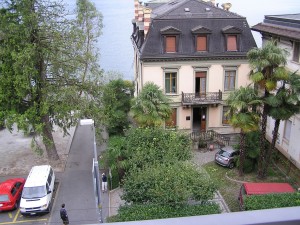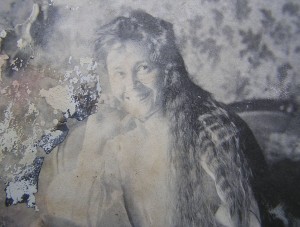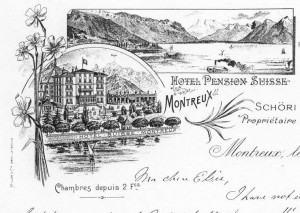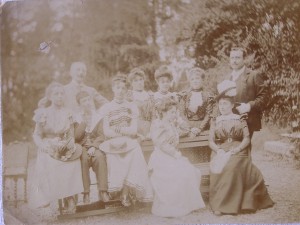
View of the Villa Monney, Montreux, from Lindsay Hall's third-floor bedroom at the Hotel Suisse. His friends, the Faletans, would try to lure him down from their balcony
At 8 o’clock on 1 January 1897, a merry, cosmopolitan party of fourteen adults and children sat down to dinner. The gathering took place at the Villa Monney, Montreux, overlooking the Lake of Geneva.
Gorgeously set against a mountain backdrop, Montreux at that time was a favourite resort of Europe’s élite. Alexandre Dumas père had called it ‘an international playground snipped off from France, Germany and Italy’. It had a casino – the Kursaal – a public park, numerous grand hotels, a railway station and a quay from which steamers regularly plied to various points around the lake. The romantic Château de Chillon nearby had been celebrated by Byron in one of his most famous poems.
In the heart of the town, the Villa Monney was the temporary base of a noble French family, consisting of the Marquis Nicolas de Faletans, a splendid, blond, moustachioed giant from the Franche-Comté; his petite Russian wife, Olga; and their pretty, teenaged daughters, Nicole and Simone.
The family had forsaken their other homes, including the Château de Faletans, near Dole, for reasons of economy. The extravagant Marquis seemed to lurch from one financial crisis to another – and Switzerland was a remarkably cheap country in which to live in those days.
The hospitable Faletans had invited their close friend, Madame Kolychko, to spend that winter with them at the villa. Born Princess Varvara Sergeevna Obolenskaya in 1862 or 3, she was amicably separated, after twelve years of marriage, from Iosif Iosifovich Kolychko. Her father’s estate in Russia, Mindukino, had been sold, her mother (re-married to an Italian, Albert Rey) lived in Milan, and Madame Kolychko herself divided her time between various European cities, including St Petersburg, always accompanied by her nine-year-old son, Boris, and his governess.
An enchanting woman, with the sort of looks that caused people to stop and stare in the streets, Madame Kolychko dressed beautifully, was graceful in her every step and movement, had a splendid voice and liked to sing Russian folksongs, accompanying herself on the guitar. She also had a very sweet nature. In the privacy of the villa, she was wont to release her long, fair curls and, in such a state of undress, even consented to be photographed, grinning shyly into the camera.
It is fortunate that the Marquis was a keen amateur photographer. Such informal photographs are very rare from this period. I rescued this one from the damp attic of a country house in France. Despite the damage, it conveys a clear idea of Madame Kolychko’s exceptional looks and personality.
A solitary Englishman was present at dinner that evening. With his distinctive white beard and black velvet coat, Lindsay Hall was a familiar and much-loved figure in Montreux. A retired cotton-broker from Liverpool, Hall resided permanently at the Hôtel Suisse, one of Montreux’s foremost hotels, which towered over the rear of the Villa Monney and had a garden stretching down to the lake.
The Faletans had befriended Hall on his first arriving at Montreux, in March 1896, they themselves having been in residence since the previous September. The Marquis had attempted to photograph his daily ritual which was to feed the birds, a frantic flurry of squawking seagulls and swans, from the garden wall of the lake. Hall would happily entertain young Nicole and Simone and Boris for hours in the garden. Luckily, the foreigners all spoke good English, as Hall himself was no linguist.
Hall had embarked at Montreux on a most delightful new life. He had discovered, apparently for the first time, that he had a remarkable gift for friendship. Owing to some indefinable quality, this slight, unassuming old man was simply adored by men and women of every age and nationality.
He seems to have been a joyous companion, endlessly fascinated by other people, concerned for their well-being and determined to bring happiness to their lives. They universally responded with affection and even utter devotion.
The Faletans, who were a kind and unstuffy family, had taken him under their wing and introduced him to all the élite of Montreux. He spent most of every day with them, escorting them to the daily concerts at the Kursaal and then to afternoon tea at the Tennis Club in Territet, and, on summer evenings, sitting up late with them in the hotel garden.
Hall was virtually a pauper, yet he lived in great comfort at the hotel, for the cost of living in Switzerland in those days was, indeed, remarkably low. Lindsay Hall, who survived on ‘less than £100 a year’, hardly exaggerated when he said it was about a tenth of what it was in England.
He had a bright little bedroom on the un-electrified third floor, looking directly onto the Villa Monney. Often he would see his friends the Faletans on the balcony, beckoning to him to come down, or pointing to the lake if an excursion was planned.
He was somewhat torn between his devotion to Olga and to Madame Kolychko, whom he called ‘the princess’. The ladies seem to have competed good-humouredly for his time and affection. At that memorable New Year’s dinner party, he was favourably seated between them. They courteously spoke only in English, whilst he ‘amused them at times to screaming laughter by my attempts at French humour, but they say I am much improving’. Among the other guests were Jeanne Daudet – the adored granddaughter of Victor Hugo, daughter-in-law of the novelist Alphonse Daudet and ex-wife of the journalist Léon (to whom Proust was to dedicate Le Côté de Guermantes) – and Jeannine d’Hauterive, daughter of Alexandre Dumas fils. Hall observed the ‘different ways & manners’ with fascination.
Through a fog of cigar smoke, the Marquis told the men of his work in Belgium, which accounted for his frequent absences. He was an inventor, specialising in armaments, He had already secured a significant contract to modify the rifles of the Russian army, and was now looking for similar contracts elsewhere. He travelled all over Europe and was often in Russia, where he had held a post at the Embassy.
Hall, who struggled to keep up with conversations of this sort, had a merry time instead with the women. Young Nicole, excitedly and in stuttering English, embarked on some elaborate story about a dog. Apparently it had belonged to Madame Daudet’s grandfather, Victor Hugo. It was a poodle – not a toy poodle, a proper one, bred for hunting – and had become a nuisance to its master, requiring constant attention. On a whim, he had given the dog to Nicole’s Papa, who had taken it with him to Russia, but one day the dog had vanished and then a month later had turned up in Paris in a terrible state, barking feebly at its master’s door. No one could explain how it had made such a journey in so short a time, or how it had found its way. Madame Daudet had smiled and nodded in verification of the tale. She had known the dog and had grown up with it in her grandfather’s house on Guernsey, for Hugo had been deeply moved by its devotion and had sworn never to be parted from it again.
Neither Madame de Faletans nor Madame Kolychko could have predicted how involved they would both become with Lindsay Hall. Was he in love with them, and why did they find him so appealing? I suspect that both women, neglected by their husbands, were flattered by his attention, his willingness to listen to them and notice them, without ever feeling challenged sexually (Hall was in his late sixties and a very proper Victorian). Hall may have wished it were otherwise, but a barrier of formality seems always to have been maintained, apart from some mild flirting.
The picture reproduced here is marked in pencil on the back: ‘Madame Kolychko, Villa Monney, 1897’. I am unable to identify her positively in any other photograph. According to the Obolensky family genealogy, she survived Lindsay Hall by 46 years, dying on 18 March 1956, aged 93. I have no further information about her long life, nor do I know what became of her son, Boris Iosifovich Kolychko. One hopes that he survived the twin calamities of the Great War and the Russian Revolution. It would be sad to think that nothing of Madame Kolychko, who made such an impression on contemporaries, had outlived her, not even a memory. I hope that I, in telling her story, have provided a fitting memorial.
[See Nicolas Ikonnikov, La Noblesse de Russie, Tome K.2 (Paris, 1960), ‘Les princes Obolensky’, no.261. Comments and further information will be gratefully received at RupertWilloughby@btinternet.com.]



